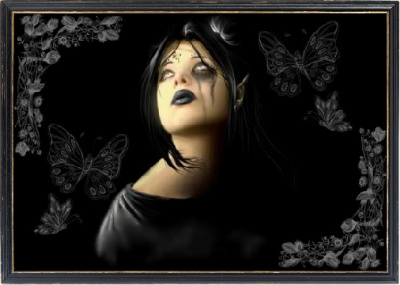Magic but not exactly witchcraft as most think of it.
18:05 Feb 03 2014
Times Read: 392
SEIDR
From the Old Norse: Seidr is a type of Shamanistic folk magic and Shamanic technique practised by solitary Witches and healers. Traditionally - Seidr included both healing; shape-shifting, curses and raising storms, etc. A good portion of Seid magic was concerned with communication with spirits.
The term Seidr is most commonly translated as "Witchcraft" and is used to describe actions ranging from shamanic magic (such as spirit journeys; magical healing by removing "spirit missiles" such as elf-shot from the body, magical psychiatric treatment in the form of recovering lost portions of the soul-complex, etc.) to prophecy, channelling the Gods or the Gods' voices through a human agent; performing magic that affects weather or animal movements, as well as a wide range of malefic magic. The single most characteristic element of Seidr - however - seems to be magic of a type which works by affecting the mind by illusion, madness, forgetfulness or other means.
The way in which to affect the mind is by a means of Transmigration (projection into someone's psyche) to transfix then transmit negative signals!
The practitioner of Seidr was known as a Seid-Kona (seid-wife) or Seid-Madhr (seid-man)
The Goddess Freyja is the patroness of Seidr.
http://wulfe.webs.com/seidr.htm
Excerpts from Wikipedia:
http://en.wikipedia.org/wiki/Sei%C3%B0r
Seid or seiðr is an Old Norse term for a type of sorcery or witchcraft which was practiced by the pre-Christian Norse. Sometimes anglicized as "seidhr," "seidh," "seidr," "seithr," or "seith," the term is also used to refer to modern Neopagan reconstructions or emulations of the practice.
Mythology
The goddess Freyja is identified in Ynglinga saga as an adept of the mysteries of seid, and it is said that it was she who taught it to Odin: Dóttir Njarðar var Freyja. Hon var blótgyðja. Hon kenndi fyrst með Ásum seið, sem Vönum var títt ('Njörðr’s daughter was Freyja. She presided over the sacrifice. It was she who first acquainted the Æsir with seiðr, which was customary among the Vanir').
In Lokasenna Loki accuses Odin of practicing seid, condemning it as an unmanly art. A justification for this may be found in the Ynglinga saga where Snorri opines that following the practice of seid, the practitioner was rendered weak and helpless.
One possible example of seid in Norse mythology is the prophetic vision given to Odin in the Völuspá by the völva, vala, or seeress after whom the poem is named. Her vision is not connected explicitly with seiðr; however, the word occurs in the poem in relation to a character called Heiðr (who is traditionally associated with Freyja but may be identical with the völva). The interrelationship between the völva in this account and the Norns, the fates of Norse lore, are strong and striking.
Another noted mythological practitioner of seiðr was the witch Groa, who attempted to assist Thor, and who is summoned from beyond the grave in the Svipdagsmál.
Origins
Shamanism refers to traditions which have been maintained widely throughout the world and are probably of prehistoric origin. Since the publication of Jakob Grimm's socio-linguistical Deutsches Wörterbuch (p. 638) in 1835, scholarship draws a Balto-Finnic link to seid, citing the depiction of its practitioners as such in the sagas and elsewhere, and link seid to the practices of the noaidi, the patrilineal shaman of the Sami people. However, Indo-European origins are also possible. Note that the word seita (Finnish) or sieidde (Sami) is a human-shaped body formed by a tree, or a large and strangely shaped stone or rock and does not involve "magic" or "sorcery;" there is a good case, however, that these words do derive ultimately from seiðr.
Belief in witchcraft has been part of Germanic religion from earliest times. Jordanes in his De Origine Actibusque Getarum (Origins and Deeds of the Goths) gives an account of the origins of the Huns from the union of witches with "unclean spirits." These witches are said to have been expelled from the army of the Goths by king Filimer (fl. late 2nd century). Jordanes gives the Gothic name of these magae mulieres as haliurunnae (sg. *haljaruna). Old English has hellrúna (f. hellrúne) "witch," Old High German has hellirúna "necromancy."
Contemporary reconstruction
Diana Paxson and her group, Hrafnar, have attempted reconstructions of seid from available historical material, particularly the oracular form. Jan Fries regards seid as a form of 'shamanic trembling' which he relates to "seething," used as a shamanic technique, though he is less concerned with precise historical reconstruction, the idea being his own and developed through experimentation. See further the works of Jenny Blain, which discusses different ways in which seidr is being re-constituted today, in Scandinavia, the United Kingdom and the United States from the point of view as a practitoner and an ethnographer.
Within British Heathenry, seidr according to Blain (2002) is becoming an intrinsic part of spiritual practice. This is not necessarily 'reconstruction,' but may relate more to associations of people, land, and spirits.
It has been suggested that during seances the seiðkona would enter a state of trance in which her soul was supposed to "become discorporeal," "take the likeness of an animal," "travel through space," and so on. This state of trance may have been achieved through any of several methods: entheogens, sleep deprivation, sensory deprivation, for instance Galdra, which is the chanting of galdrar, is also involved in creating the state of trance.
http://en.wikipedia.org/wiki/Sei%C3%B0r
Galdr - Chanting the Runes
"Galdr or Galdor, from the Old Norse, originally meant "incantation". The verb "gala" is also used for "to crow". It later came to mean magic in general."
http://forums.skadi.net/showthread.php?t=105022







COMMENTS
-